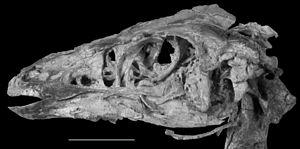Sinornithomimus
| Sinornithomimus | ||||||||||||
|---|---|---|---|---|---|---|---|---|---|---|---|---|

Skull of Sinornithomimus dongi |
||||||||||||
| Temporal occurrence | ||||||||||||
| Upper Cretaceous ( Turonium ) | ||||||||||||
| 93.9 to 89.7 million years | ||||||||||||
| Locations | ||||||||||||
| Systematics | ||||||||||||
|
||||||||||||
| Scientific name | ||||||||||||
| Sinornithomimus | ||||||||||||
| Kobayashi & Lü , 2003 |
Sinornithomimus is a genus of dinosaurs from the group of Ornithomimosauria within the Theropoda . He lived in the early Upper Cretaceous in what is now East Asia.

features
Sinornithomimus resembled the other members of the Ornithomimidae in its physique : it was a slender, lightly built dinosaur that moved biped (on its hind legs). The small, lightly built skull sat on a long neck. The snout was elongated and had a horned beak at the tip, like all Ornithomimidae it was toothless. The big eyes sat on the side of the head. The forelimbs were relatively large, but weakly built. The hands carried three fingers with blunt claws. The hind legs were longer than the front legs, and the lower legs and metatarsals were elongated. The foot had three protruding toes. It differs from other Ornithomimidae in details in the structure of the skull like an indentation in the parietal bone .
Paleobiology
Due to the construction of the hind legs, it is believed that Sinornithomimus could walk quickly. The remains of at least 14 animals, including a striking number (11) young animals, were found at the site. In the young animals, the tibia was even shorter in relation to the thigh bone , so they have probably not yet reached the speed of adult animals. The find suggests that these dinosaurs lived together in groups, at least for a time - possibly to protect them from predators. They must all have perished together, perhaps as a result of a natural disaster.
Gastroliths (stomach stones) were discovered in the abdominal cavity of these animals . The position of the gastroliths within the torso could indicate that the dinosaurs had gizzards , similar to today's herbivorous birds , and swallowed stomach stones to better break up the food. This discovery is an indication that these animals may have been herbivores.
Discovery and naming
The fossil remains of Sinornithomimus were found in the Ulansuhai Formation in Inner Mongolia ( China ) and were first described in 2003 . The name means "Chinese bird imitator" and is a reference to Ornithomimus , the first known representative of the Ornithomimosauria. The type species and only described species is Sinornithomimus dongi . The finds are dated in the early Upper Cretaceous ( Turonian ) to an age of 94 to 90 million years. This makes this dinosaur one of the older representatives of the Ornithomimidae.
literature
- David J. Varricchio, Paul C. Sereno, Zhao Xijin, Tan Lin, Jeffery A. Wilson, Gabrielle H. Lyon: Mud-Trapped Herd Captures Evidence of Distinctive Dinosaur Sociality . In: Acta Palaeontologica Polonica . tape 53 , no. 4 , 2008, p. 567-578 , doi : 10.4202 / app.2008.0402 (free full text).
- Peter J. Makovicky , Yoshitsugu Kobayashi, Philip J. Currie : Ornithomimosauria. In: David B. Weishampel , Peter Dodson , Halszka Osmólska (eds.): The Dinosauria. 2nd edition. University of California Press, Berkeley CA et al. 2004, ISBN 0-520-24209-2 , pp. 137-150.
Web links
Individual evidence
- ^ Gregory S. Paul : The Princeton Field Guide To Dinosaurs. Princeton University Press, Princeton NJ et al. 2010, ISBN 978-0-691-13720-9 , p. 113, online .
- ^ Y. Kobayashi, JC Lu: A new ornithomimid dinosaur with gregarious habits from the Late Cretaceous of China . In: Acta Palaeontologica Polonica . tape 48 , no. 2 , 2003, p. 235–259 ( full text [PDF; 2.7 MB ]).